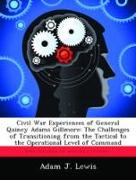- Start
- Civil War Experiences of General Quincy Adams Gillmore: The Challenges of Transitioning from the Tactical to the Operational Level of Command
Civil War Experiences of General Quincy Adams Gillmore: The Challenges of Transitioning from the Tactical to the Operational Level of Command
Angebote / Angebote:
A leader's transition from the tactical to operational level of command has challenged military commanders throughout history. Some leaders are very successful at making the transition, while others encounter difficulty. Understanding the commonalities and differences in leadership at these two levels of command is helpful toward better preparing our leaders to understand and succeed at both levels. Union Army General Quincy Adams Gillmore provides an excellent case study for comparison of tactical level versus operational level command. Gillmore experienced success in tactical engagements but was challenged when required to lead a military campaign. Gillmore's 1863 campaign against the Confederates defending Charleston provides an interesting case in operational level leadership, especially when analyzed against his education, military background, and tactical command experiences. This monograph explores from General Gillmore's early life through to his command of the campaign against Charleston. First, it examines Gillmore's educational background and provides additional context with a brief overview of his military career. Second, it examines two of Gillmore's most significant tactical experiences at Fort Pulaski and the Battle of Somerset. It assesses Gillmore's tactical performances in each of these experiences by answering the following questions: Did General Gillmore accomplish his directed task and purpose? Did he understand the capabilities and intentions of the enemy in relation to the terrain? How did he operate in light of these factors? Third, the monograph analyzes Gillmore's performance in the Charleston campaign. It assesses his performance by determining whether he accomplished the strategic aim. It also assesses his ability to sustain his forces for the duration of the campaign. Additionally, it analyzes his level of creativity during the Charleston campaign. Did he seek to create additional options for his forces? Finally, the monograph searches
Folgt in ca. 15 Arbeitstagen



